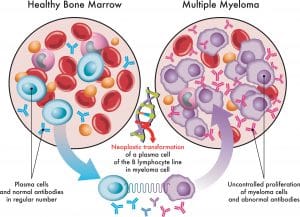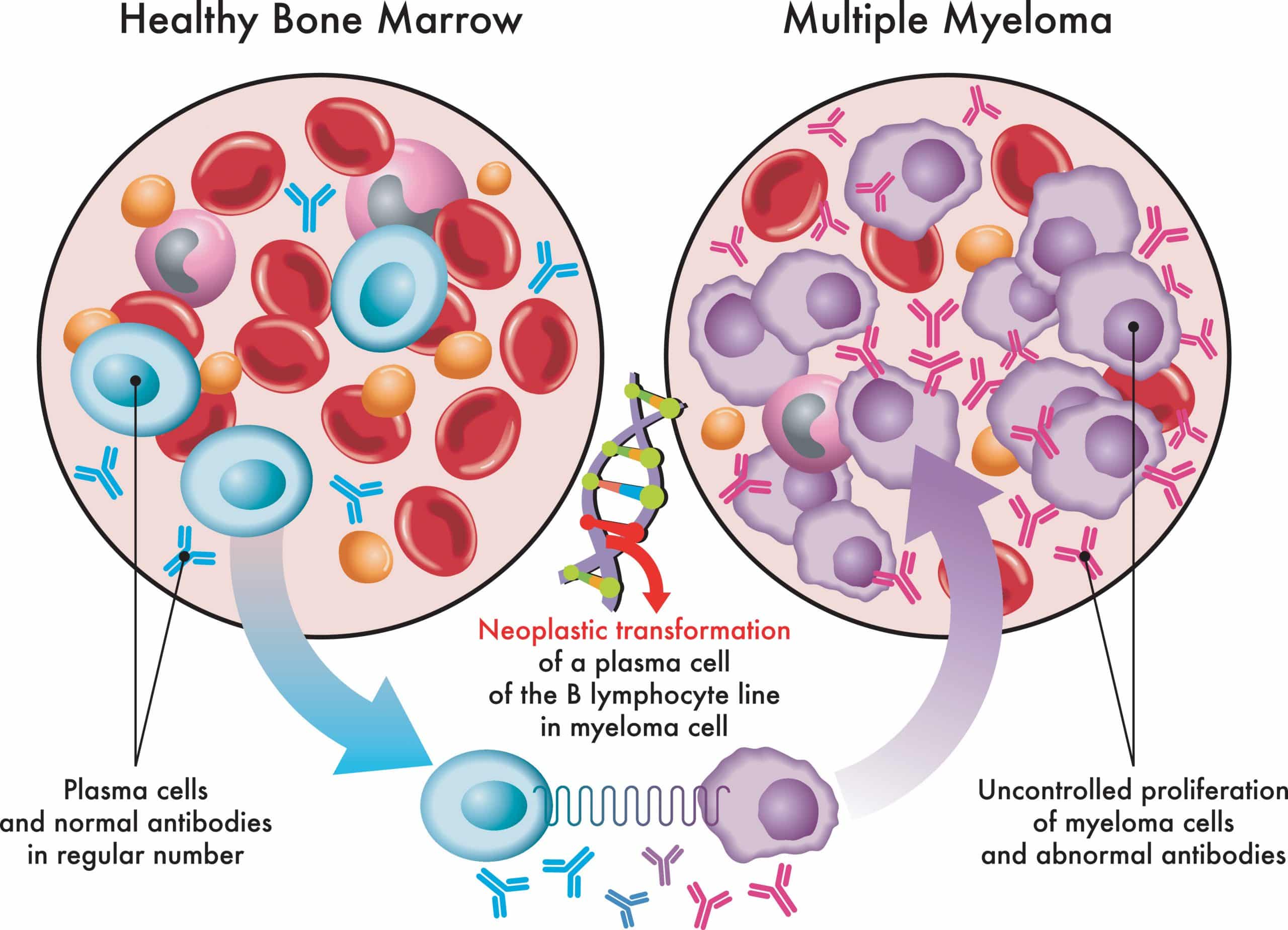Customized Exercise Programming – Multiple Myeloma

- Jan is 42 years old and was an avid exerciser prior to her cancer diagnosis.
- She is 5’2″ and currently 150 lbs. She has 17% body fat.
- She is currently on a combination of bortezomib, lenalidomide, and dexamethasone
- Her blood counts show moderate leukopenia and thrombocytopenia
- She is currently undergoing chemotherapy and plasmapheresis
- She has painful neuropathy in both hands and feet and has a difficult time standing
- She has lyctic lesions and compression fractures in L4/L5
- She has trouble sleeping, and elevated blood sugar levels, due to the steroid medication
- She has extreme fatigue and chemo-brain
- She has a difficult time with her short-term memory and completing basic tasks
- Her BP is 110/85 and her RHR is 78.
- Moderate upper-crossed syndrome
- Moderate anterior pelvic tilt
- Struggles with balance on both sides
- Avoid squat test because of compression fractures
- Modified Thomas Test confirms tight hip flexors and quads on both sides. Tom is overwhelmed with the combination of Jan’s treatment, side-effects, and physical assessment, as well as his concern for spinal cord compression. He is not sure where to begin.
I started by compiling my own notes and breaking everything down for him one step at a time.
- Because Jan has neuropathy in her hands, Tom will need to choose upper body exercises that don’t put her at risk of dropping the weights or letting go of the bands. He will focus on machines and isometrics for her upper-body workout. Because Jan also has neuropathy in her feet, he will avoid all high-impact activities completely and start with a recumbent bike for cardio because of her elevated risk of falling, bruising easily due to low platelets, and discomfort and pain. When she is through with treatment and her blood counts are good, swimming will be a great option. Jan has trouble with balance because of neuropathy and extreme fatigue, so balance work will be critical.
- Since Jan began chemotherapy, she has been vomiting several times per week, which has added to her fatigue.
- On days that Jan has vomiting, she will need to avoid exercise for 24-36 hours and make sure that she re-hydrates and replenishes electrolytes. If she has spells of nausea, Tom will tell her to stop exercising, sit down, and drink water. If the feeling does not pass, he will suggest that Jan go home.
- Tom will also incorporate lower-body ‘functional’ exercises, starting with wall-sits and working up to wall squats with a small physioball supporting the lumbar area to help increase her bone density and perform activities of daily living. He will also work with Jan on gentle stretches for her adductor complex, quads, and hip flexors. Cardio will help to strengthen her heart and lungs, increase her energy, and help her lose body fat.
- Because of the upper-crossed syndrome, Jan needs to stretch both her pecs and lats. She should focus on shoulder retraction and depression to stabilize her shoulder girdle. To strengthen the opposing upper/middle back muscles she will start with isometric reverse flys and shoulder scaption – just a few repetitions to begin with.
- Because Jan is extremely fatigued, Tom is suggesting she exercise for 20-30 min. 3-4 times a week, or as tolerated. Since she is currently undergoing treatment (and extremely fatigued and low-functioning), she should only be at 20-40% of his Karvonen heart rate. Because of COVID and Jan’s already compromised immune system, Tom arranges ZOOM calls for their workouts. Jan always has someone there in her home during his exercise sessions to help with balance, prevent injuries, and be there in case of an emergency.
- Tom wants to get Jan in a swimming pool when her blood counts improve, and COVID is not an issue.
- Tom will refer Jan to a Registered Dietician who specializes in oncology to help put together a meal plan that will ensure that she is getting the appropriate nutrition and help with building lean muscle mass.
Once I gathered my thoughts, I was able to come up with the following workout routine for Tom to facilitate with Jan for her initial 6-8 weeks.
DAILY deep breathing exercises and 10-minutes of meditation and gratitude. Jan will use the recumbent bike in her living room for 5 minutes a day (when she has the energy), working up to 10-15 minutes each day as tolerated. If her energy is really low, she can break this into 5-minute increments (or whatever she can do without becoming more fatigued). Done properly, Jan should feel energized (or at least no more fatigued than when she started). Following her cardio session, Jan will do a corner or door stretch for her chest (careful to avoid an excessive pelvic tilt and stress on her lumbar spine), a lat stretch while sitting on a chair, sliding both arms forward on her kitchen table (palms facing one another), and a quad/hip flexor stretch while seated with one leg hanging off of the side of the chair (focusing on engaging glutes and avoiding excessive anterior tilting). Tom will also give Jan a routine to help minimize some of her neuropathy side-effects on upper body and lower body.
Balance exercises and core exercises will be critical for fall and injury prevention. Tom must make sure that Jan has something stable to hold on to or has a spotter in the house and nearby. Tom encourages Jan to sit on a 55″ physioball placed in a corner. Her spotter should be standing in front of her so that she has little-to-no chance of falling. She will proceed with “pelvic clock” exercises in each direction. Since the doctor has advised against lumbar flexion and extension, pelvic tilts should be avoided for the time being.
2 x PER WEEK Lower-body strength training – starting with functional training. Jan will place a band around her thighs and push her thighs outward during her wall-sit. The goal is 3-4 reps (holding each for 10 sec. or as long as Jan can tolerate) and stop if she gets too fatigued. Tom will also have Jan do side-lying clams. Jan will place a pillow under her head and make sure her spine is in alignment. They will aim for 8-10 reps on each side. Fatigue will be the determining factor for the number of reps as they progress. As it becomes easier, Tom may suggest that Jan add a circular band around her thighs to add resistance. Tom needs to make sure that whatever they do gives Jan more energy rather than causing her to be more fatigued.
On two of the non-leg days, Jan will perform exercises that challenge her memory. Tom will have Jan perform a set of 6 reps of a particular movement; let’s say toe raises. Then he will add another exercise; maybe seated rows on a physioball. Jan will have to remember the first set of toe raises, perform 6 of them, do another set of rows, and then Tom will add another exercise, and so on and so on. Jan may get frustrated when she can’t remember what comes next, and Tom can remind her that many of the side effects of treatment will lessen or go away completely over time. Tom will encourage her to keep pushing ahead, but also knows when Jan needs to take a “step back.”
Tom will re-assess Jan in 8-12 weeks and either continue with this routine, or progress to a longer duration of cardio, more repetitions, and the addition of more strength training, multi-planar, and balance exercises.
**Keep in mind that the long-term risk of osteoporosis, diabetes, damage to the heart, lungs, and kidneys, and risk of future cancers is elevated due to chemotherapy and adjuvant medications. Therefore, a proper balance of strength training, cardio, and weight and stress management are critical for survivorship and quality of life.
**Because spinal cord compression is a concern with patients with MM you must be aware of any sudden changes in cognition, mobility, and reflexes and have them contact their doctor IMMEDIATELY if they are symptomatic. The sooner it is diagnosed, the better the long-term prognosis.
If you are in need of assistance with a special-needs or physically-challenged client, you can get Andrea Leonard’s help with custom exercise programming.

